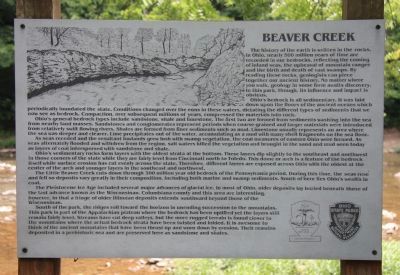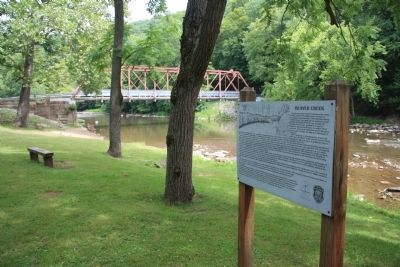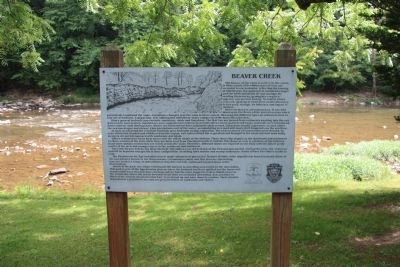Near East Liverpool in Columbiana County, Ohio — The American Midwest (Great Lakes)
Beaver Creek
Ohio's bedrock is all sedimentary. It was laid down upon the floors of the ancient oceans which periodically inundated the state. Conditions changed over the eons in these waters, dictating the different types of sediments that we now see bedrock. Compaction, over subsequent millions of years, compressed the materials into rock.
Ohio's general bedrock types include sandstone, shale and limestone. The first two are formed from sediments washing into the sea from nearby land masses. Sandstones and conglomerates represent periods when coarse-grained and larger materials were introduced from relatively swift flowing rivers. Shales are formed from finer sediments such as mud. Limestone usually represents an area where the sea was deeper and clearer. Lime precipitates out of the water, accumulating as a mud with many shell fragments on the sea floor.
As seas receded and the resultant lowlands grew lush with swamp vegetation, the coal measures of eastern Ohio were formed. As seas alternately flooded and withdrew from the region, salt waters killed the vegetation and brought in the sand and mud seen today as layers of coal interspersed with sandstone and shale.
Ohio's sedimentary rocks form layers with the oldest strata at the bottom. These layers dip slightly to the southeast and northwest in those corners of the state while they are fairly level from Cincinnati north to Toledo. This dome or arch is a feature of the bedrock itself while surface erosion has cut evenly across the state. Therefore, different layers are exposed across Ohio with the oldest at the center of the arch and the younger layers in the southeast and northwest.
The Little Beaver Creek cuts down through 300 million year old bedrock of the Pennsylvania period. During this time, the seas rose and fell so deposits vary greatly in their composition, including both marine and swamp sediments. South of here lies Ohio's wealth in coal.
The Pleistocene Ice Age included several major advances of glacial ice. In most of Ohio, older deposits lay buried beneath those of the last advance known as the Wisconsinan. Columbiana county and this area are interesting, however, in that a fringe of older Illinoian deposits extends southward beyond those of the Wisconsinan.
South
of the park, the ridges roll toward the horizon in unending succession to the mountains. This park is part of the Appalachian plateau where the bedrock has been uplifted yet the layers still remain fairly level. Streams have cut deep valleys, but the more rugged terrain is found closer to the mountains where the actual bedrock strata have been twisted and folded. It is awesome to think of the ancient mountains that have been thrust up and worn down by erosion. Their remains deposited in a prehistoric sea and are preserved here as sandstone and shales.
Erected by Ohio State Parks, Department of Natural Resources.
Topics. This historical marker is listed in this topic list: Natural Resources.
Location. 40° 43.632′ N, 80° 36.679′ W. Marker is near East Liverpool, Ohio, in Columbiana County. Marker is on Echo Dell Road (Local Route 929) north of Bell School Road (Local Route 1131), on the right when traveling north. This historical marker is located at Beaver Creek State Park along the south bank of Little Beaver Creek, between the Gaston Mill and the 1910 steel framed bridge across Little Beaver Creek. Touch for map. Marker is in this post office area: East Liverpool OH 43920, United States of America. Touch for directions.
Other nearby markers. At least 8 other markers are within 7 miles of this marker, measured as the crow flies. Little Beaver Creek (here, next to this marker); Lock 36 (within shouting distance of this marker); Thomas J. Malone Bridge / Gaston's Mill (about 300 feet away, measured in a direct line); Death of Pretty Boy Floyd (approx. 1˝ miles away); Dustin Huffman Memorial Overlook (approx. 2.1 miles away); Church Hill Road Bridge / Timber Covered Bridges (approx. 5.4 miles away); Riverview Cemetery (approx. 6˝ miles away); New Salem Presbyterian Church (approx. 6.8 miles away in Pennsylvania). Touch for a list and map of all markers in East Liverpool.
Credits. This page was last revised on June 16, 2016. It was originally submitted on May 5, 2012, by Dale K. Benington of Toledo, Ohio. This page has been viewed 788 times since then and 27 times this year. Photos: 1, 2, 3. submitted on May 5, 2012, by Dale K. Benington of Toledo, Ohio.


